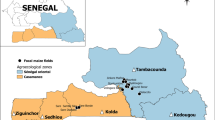Abstract
Early biological control attempts ofDiatraea saccharalis in Barbados had failed. Subsequent intensive release campaigns of several parasite species from the Neotropics. Africa and India resulted in the temporary establishment ofMetagonistylum minense andTrichogramma japonicum and the permanent establishment ofLixophaga diatraeae andApanteles flavipes. The latter built up an extraordinarily high population level within a short period of time. From damage assessments it is evident that due to high parasitism crop damage was reduced considerably. The joint borer infestation which fluctuated around 15% until 1966 decreased to less than 6% in 1970.
Résumé
Des essais de lutte biologique contreDiatraea saccharalis ont été poursuivis à la Barbade pendant plus de 40 ans. Des libérations en masse deTrichogramma japonicum, faites jusqu’en 1958, se révélèrent infructueuses; la mouche de Cuba,Lixophaga diatraeae, fut introduite au début de l’année 1960, mais sa répartition demeura inégale et sa fréquence généralement faible jusqu’en 1968, date à laquelle elle se répandit soudain dans toute l’île et augmenta en abondance (moyenne de parasitisme en 1968: 13,6%). Tout s’est passé comme si, durant les années précédentes, une race s’était développée qui est maintenant mieux adaptée aux conditions environnantes de la Barbade.
En 1966 et 1967, plusieurs autres espèces de parasites furent introduites à la Barbade. Parmi elles,Metagonistylum minense etTrichogramma fasciatum s’établirent temporairement, tandis queApanteles flavipes, introduite des Indes, s’acclimata d’elle-même en permanence. A la suite d’une libération d’environ 2 000 individus en juillet et août 1966, ce parasite fut retrouvé pour la première fois, plus d’un an après, en octobre 1967; à la fin de 1969, il avait colonisé toute l’île avec un taux de parasitisme de 0,5 à 95,5% et en moyenne de 30,3%. Ces deux dernières années, la réduction des dégâts a produit une augmentation de revenu estimée à 315 000 et 405 000 £, respectivement.
Similar content being viewed by others
References
Bennett, F. D. — 1965. Tests with parasites of Asian graminaceous moth-borers onDiatraea and allied genera in Trinidad. —Commonw. Inst. Biol. Cont. Tech. Bull.,5, 101–116.
Bennett, F. D. & Pschorn-Walcher, H. — 1968. Recent investigations on the biological control ofDiatraea spp. in Trinidad, the Lesser Antilles and Barbados. —I.S.S.C.T. Proc. 1968,13th Congr., Taiwan, 1321–1330.
Bennett, F. D. & Carl, K. — 1969. Recent laboratory trials with exotic parasites onDiatraea spp. in Trinidad. —Proc. 2nd Conf. Sugar Technol. Assoc. T’dad and T’go, 63–66.
Box, H. E. — 1937. Sugarcane moth-borer investigations. No. 3. —Col. Dev. Fund (Antigua).
Davis, E. G., Horton, J. R., Gable, C. H., Walter, E. V. & Blanchard, R. A. —1933. The southwestern corn borer. —Tech. Bull. U.S. Dep. Agr. No. 388, 61 pp.
Gifford, J. R. &Mann, G. A. — 1967. Biology, rearing and a trial release ofApanteles flavipes in the Florida Everglades to control the sugarcane borer. —J. econ. Entomol.,60, 44–47.
Metcalfe, J. R. — 1959. A preliminary reassessement ofDiatraea saccharalis (F.) in Barbados, West Indies. —Trop. Agric., Trinidad,36, 199–209.
Metcalfe, J. R. — 1960. The introduction of larval parasites of moth borerDiatraea saccharalis (F.) into Barbados — A progress report. —Dept. Agric., Barbados, W.I.
Rao, V. P. &Nagaraja, H. — 1967. Validity of the specific status ofApanteles chilonis (Munakata). —Commonw. Inst. Biol. Cont. Tech. Bull.,9, 45–49.
Van Whervin, L. W. — 1963. The biological control of the moth borerDiatraea saccharalis (F.) with special reference toLixophaga diatraeae Tns —Min. Agric., Lands & Fisheries, Barbados, Bull.,35, 1–22.
— — 1966. Ecology, biology and behaviour ofLixophaga diatraeae Tns. —Min. Agric., & Fisheries, Barbados, Bull.,43, 1–38.
Watanabe, C. — 1965. Notes on theApanteles flavipes complex [Hymenoptera, Braconidae]. —Mushi,38, 111–116.
Author information
Authors and Affiliations
Rights and permissions
About this article
Cite this article
Alam, M.M., Bennett, F.D. & Carl, K.P. Biological control ofDiatraea saccharalis (F.) in Barbados byApanteles flavipes Cam. andLixophaga Diatraeae T. T.. Entomophaga 16, 151–158 (1971). https://doi.org/10.1007/BF02371165
Issue Date:
DOI: https://doi.org/10.1007/BF02371165




